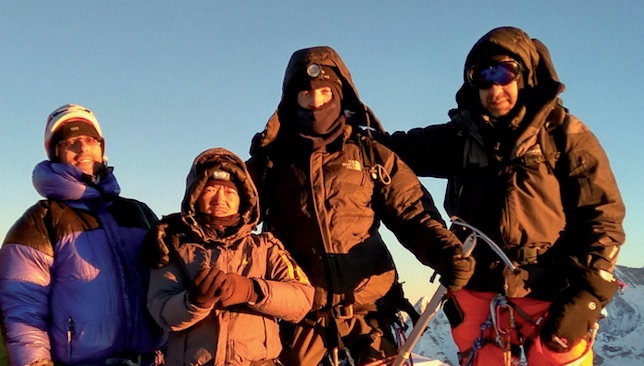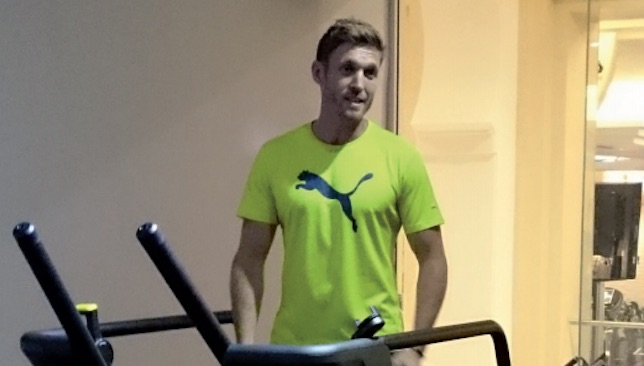
F or some of us, it’s more than enough to buckle down for a month or two to train and conquer your first triathlon or a Tough Mudder event at the weekend. And then there are folks like Tom Otton, daring to think bigger in search of more bite.
The Briton is the MD of the Create Media Group, a successful digital agency he founded in Dubai, but in his spare time, you could say he’s among the UAE’s extreme adventurists.
Last year, along with Marcus Smith of InnerFight Dubai, he successfully completed the notorious Marathon des Sables, a 250km race across the Sahara Desert, also dubbed the ‘Toughest Footrace on Earth’.
For his next trick, he chose something a little closer to the clouds – summiting Mera Peak, which, at 6,476m (21,246ft), is Nepal’s highest trekking peak. For obvious reasons, this is a novel challenge not to be taken lightly, and if you are ready to test your fitness and mettle in the new year with something similar, something stickier, then read on to see what it might require of you and your body.
“I enjoy putting myself into difficult situations and seeing how I respond, and in terms of height, this was probably one of the most strenuous things I’ve ever done,” says Otton, who succeeded in his Nepal feat last month while also raising funds for Tanzania orphanage Larchfield Kids.
Otton’s focused training started two to three months prior in Dubai where weather and terrain are already polar opposites to the cold and unforgiving, hilly Himalayas. Testing out all your hefty kit in breaking the ice Tom Otton on how gym work was key to him Jebel Hafeet and Wadi Showka is one thing, but he knew how crucial it was to find any possible means of simulating the situation his body and vitals would face in the low oxygen region, too.
“At such high altitude, your body is constantly operating at a higher frequency, or a faster pace, than at sea level. The oxygen level up at the summit is only about 40-50 per cent, which obviously causes you to breathe a lot more, sets your heart rate much higher, wears you out much quicker,” says the 34-year-old.
“Even your base rate when you’re trying to sleep up there is way up – you’re burning huge amounts of calories as your body tries to suck in whatever energy it can find. So if you can’t get the food down, then this scenario just sort of starts to cannibalise the rest of your body.”
Tackling that issue in the desert obviously has its challenges, but it is doable. Otton was lucky to have TechnoGym on board for training support, and can’t credit their cutting-edge non-motorised treadmill, the Skillmill, enough for its effectiveness in boosting his strength and endurance.
Primarily designed to help everyday athletes improve their power, speed, stamina and agility, the Skillmill is capable of training all the body’s energy systems in a single solution, from sprinting to power development, for efficient metabolic conditioning. It hones an individual’s ability to carry out complex movements requiring good neuromuscular coordination.
“With the Skillmill, when you really crank the gears up high, so much so you kind of have to lean into it and drive your legs, that just activates your posterior chain really well, which is exactly what you need when hiking up a mountain,” added Otton.
On top of that, he had access to Talise Fitness’ High Altitude Chamber, designed to enhance your aerobic capacity and adapt your body to a low-oxygen atmosphere.
“That was awesome because I’d just have to go in there with the Skillmill and crank it up to about 3,000 metres (by decreasing the level of oxygen in the room),” he said.
Combining these two technologies three days a week, alongside functional strength work and cardio outside of the chamber (with weights and kettlebells, a few long runs, as well as sprint work), provided just enough for him to manage on the mountain (and bear in mind Otton was at a fairly high fitness level to begin with). But he hadn’t fully realised that he was training more for a sprint than a marathon until he got to Base Camp.
“You’d think that hiking at high altitude would be all about longer-term cardio, about being able to endure longer, monotonous distances and that, but it’s actually the opposite, I learned,” he added.
“Up on the mountain, because you’re struggling so much to get oxygen in, your body reacts a lot more like it’s doing sprint sessions – even if all you’ve done is 10 paces while hefting your pack in your crampons (snow/ice shoe grips).
“It’s true you can’t really fully acclimatise for Mera Peak by doing a few hours in the Chamber a week, but what it does is replicate the experience of working hard at high altitudes so that way I was able to work out how hard I could push myself and more.

Maximum endurance skills: Tom Otton on the TechnoGym Skillmill.
“I was then able to understand my body more at altitude because I had worked out hard at altitude on the ground. But I must say, in hindsight, I’d probably go back and do less long runs and focus more on interval and heart rate training if I did it again.” Nutrition, you would think, is big ground to consider too, but ultimately, all the bulking up Otton did on the ground was simply in anticipation of the fact that he knew he would be burning heaps of calories and losing weight on Mera.
Trekkers usually just about sustain themselves on dhal curry served at one of the small stone-hut teahouses on your way up to the top – if and when they can muster any energy to do so.
“The thing is, when you get to higher altitudes it really affects the body – you get splitting headaches, nausea… It makes it hard to stomach anything, to do much of anything really in -18C weather,” Otton went on.
“The last few days, I barely ate more than a meal a day, my body found it too hard. I did drink about 4-5 litres of water a day, though – that’s probably one of the best ways to, if you can’t eat, sort of work your way around the effects of altitude sickness. If you can’t do anything else, at least just keep drinking.”
If after reading this, you think your body is up for it, then be sure to add to that the right mental attitude which can ultimately help a great deal in making or breaking you on the mountain.
Otton’s final tip: “The more of these situations you put yourself through, the better you get at mastering the mental side of things, which, I feel, is more important than the fitness aspect.
“Of course as much training as possible is important but at the end of the day, for a trip like this you’ve just got to get stuck in and do it. You just need to understand that you’re going to be uncomfortable for a long period of time, and make peace with that.”
You can help Tom Otton further raise much-needed funds for Larchfield Kids by donating via their website, which can be visited at www.larchfieldkids.org.